A Vertical Joint Spacing Calculation Method for UDEC Modeling of Large-Scale Strata and Its Influence on Mining-Induced Surface Subsidence
Abstract
:1. Introduction
2. Methods
2.1. General Description
2.2. Determining VJS Based on the Key Stratum Theory
2.3. VJS Setting Based on the “Three-Zones” Theory
3. Engineering Background and UDEC Models
3.1. Modeling Prototype and Field Subsidence Observation
3.2. UDEC Models and Setup
4. Results and Discussion
4.1. Influence of VJS on Maximum Surface Subsidence
4.2. Influence of the Proposed Method on MSS
4.3. Influence of “Three-Zones” Theory on MSS
5. Summary and Conclusions
Author Contributions
Funding
Institutional Review Board Statement
Informed Consent Statement
Acknowledgments
Conflicts of Interest
References
- Guo, Q.; Guo, G.; Li, Y.; Wang, L.; Zhao, X. Stability evaluation of an expressway construction site above an abandoned coal mine based on the overlay and index method. Sustainability 2019, 11, 5163. [Google Scholar] [CrossRef] [Green Version]
- Guo, W.B.; Wang, H.S.; Dong, G.W.; Li, L. A case study of effective support working resistance and roof support technology in thick seam fully-mechanized face mining with hard roof conditions. Sustainability 2017, 9, 935. [Google Scholar] [CrossRef] [Green Version]
- Kulatilake, P.H.S.W.; Ucpirti, H.; Wang, S.; Radberg, G.; Stephansson, O. Use of the distinct element method to perform stress analysis in rock with non-persistent joints and to study the effect of joint geometry parameters on the strength and deformability of rock masses. Rock Mech. Rock Eng. 1992, 25, 253–274. [Google Scholar] [CrossRef]
- Shreedharan, S.; Kulatilake, P.H.S.W. Discontinuum–Equivalent Continuum Analysis of the Stability of Tunnels in a Deep Coal Mine Using the Distinct Element Method. Rock Mech. Rock Eng. 2016, 49, 1903–1922. [Google Scholar] [CrossRef]
- Huang, G.; Kulatilake, P.H.S.W.; Shreedharan, S.; Cai, S.; Song, H. 3-D discontinuum numerical modeling of subsidence incorporating ore extraction and backfilling operations in an underground iron mine in China. Int. J. Min. Sci. Technol. 2017, 27, 191–201. [Google Scholar] [CrossRef]
- Sherizadeh, T.; Kulatilake, P.H.S.W. Assessment of roof stability in a room and pillar coal mine in the U.S. using three-dimensional distinct element method. Tunn. Undergr. Space Technol. 2016, 59, 24–37. [Google Scholar] [CrossRef] [Green Version]
- Bai, T.; Maerten, L.; Gross, M.R.; Aydin, A. Orthogonal cross joints: Do they imply a regional stress rotation? J. Struct. Geol. 2002, 24, 77–88. [Google Scholar] [CrossRef]
- Bai, T.; Gross, M.R. Theoretical analysis of cross-joint geometries classification. J. Geophys. Res. 1999, 104, 1163–1177. [Google Scholar] [CrossRef]
- Dershowitz, W.S.; Einstein, H.H. Characterizing Rock Joint Geometry with Joint System Models. Rock Mech. Rock Eng. 1988, 21, 21–51. [Google Scholar] [CrossRef]
- Einstein, H.H.; Veneziano, D.; Baecher, G.B.; O’Reilly, K.J. The Effect of Discontinuity Persistence on Rock Slope Stability. Int. J. Rock Mech. Min. Sci. Geomech. Abstr. 1983, 20, 227–236. [Google Scholar] [CrossRef]
- Zhang, L.; Einstein, H.H. The planar shape of rock joints. Rock Mech. Rock Eng. 2010, 43, 55–68. [Google Scholar] [CrossRef]
- Narr, W.; Lerche, I. A Method for Estimating Subsurface Fracture Density in Core. Am. Assoc. Pet. Geol. Bull. 1984, 68. [Google Scholar] [CrossRef]
- Ladeira, F.L.; Price, N.J. Relationship between fracture spacing and bed thickness. J. Struct. Geol. 1981, 3, 179–183. [Google Scholar] [CrossRef]
- Huang, Q.; Angelier, J. Fracture spacing and its relation to bed thickness. Geol. Mag. 1989, 126, 355–362. [Google Scholar] [CrossRef]
- Price, N.J. Fault and Joint Development in Brittle and Semi-Brittle Rock; Pergamon Press: London, UK, 1966. [Google Scholar]
- Narr, W.; Suppe, J. Joint spacing in sedimentary rocks. J. Struct. Geol. 1991, 13, 1037–1048. [Google Scholar] [CrossRef]
- Narr, W. Fracture Density in the Deep Subsurface: Techniques with Application to Point Arguello Oil Field. Am. Assoc. Pet. Geol. Bull. 1991, 75, 1300–1323. [Google Scholar]
- Zhang, D.; Sui, W.; Liu, J. Overburden Failure Associated with Mining Coal Seams in Close Proximity in Ascending and Descending Sequences Under a Large Water Body. Mine Water Environ. 2018, 37, 322–335. [Google Scholar] [CrossRef] [Green Version]
- Li, M.; Zhang, J.X.; Huang, Y.l.; Gao, R. Measurement and numerical analysis of influence of key stratum breakage on mine pressure in top-coal caving face with super great mining height. J. Cent. South Univ. 2017, 24, 1881–1888. [Google Scholar] [CrossRef]
- Zhang, C.; Mitra, R.; Oh, J.; Canbulat, I.; Hebblewhite, B. Numerical analysis on mining-induced fracture development around river valleys. Int. J. Mining Reclam. Environ. 2018, 32, 463–485. [Google Scholar] [CrossRef]
- Qin, W.; Xu, J. Horizontal Subzone Characteristics and Methane Seepage. Adv. Civ. Eng. 2018, 2018, 9071578. [Google Scholar]
- Sun, Y.; Zuo, J.; Karakus, M.; Wen, J. A Novel Method for Predicting Movement and Damage of Overburden Caused by Shallow Coal Mining. Rock Mech. Rock Eng. 2020, 53, 1545–1563. [Google Scholar] [CrossRef]
- Xinjie, L.; Xiaomeng, L.; Weidong, P. Analysis on the floor stress distribution and roadway position in the close distance coal seams. Arab. J. Geosci. 2016, 9, 83. [Google Scholar] [CrossRef]
- Tian, C.; Liu, Y.; Yang, X.; Hu, Q.; Wang, B.; Yang, H. Development characteristics and field detection of overburden fracture zone in multiseam mining: A case study. Energy Sci. Eng. 2020, 8, 602–615. [Google Scholar] [CrossRef]
- Zhao, Y.; Wang, S.; Hagan, P.; Ren, L.; Zou, Z. Pressure-Arching Characteristics in Roof Blocks during Shallow Coal Mining. Adv. Civ. Eng. 2018, 2018, 6817059. [Google Scholar] [CrossRef]
- Wang, B.; Jiang, F.; Wang, C.; Zhang, B. Experimental Study on the Width of the Reasonable Segment Pillar of the Extremely Soft Coal Seam in the Deep Mine. Geotech. Geol. Eng. 2019, 37, 4947–4957. [Google Scholar] [CrossRef]
- Yang, D.; Guo, W.; Tan, Y. Application of magnetotelluric method to the detection of overburden failure height in shallow seam mining. Arab. J. Geosci. 2018, 11, 350. [Google Scholar] [CrossRef]
- Sun, W.; Qin, Z.; Li, Q.; Chen, G.; Li, T. Study on Optimization of Roadway Position in Pre-mining Upper Layered Concave–Convex Coal Body. Geotech. Geol. Eng. 2019, 37, 3739–3748. [Google Scholar] [CrossRef]
- Huang, Q.; Wu, B.; Cheng, W.; Lei, B.; Shi, H.; Chen, L. Investigation of permeability evolution in the lower slice during thick seam slicing mining and gas drainage: A case study from the Dahuangshan coalmine in China. J. Nat. Gas Sci. Eng. 2018, 52, 141–154. [Google Scholar] [CrossRef]
- Wang, S.R.; Wu, X.G.; Zhao, Y.H.; Hagan, P.; Cao, C. Evolution characteristics of composite pressure-arch in thin bedrock of overlying strata during shallow coal mining. Int. J. Appl. Mech. 2019, 11, 1950030. [Google Scholar] [CrossRef]
- Qian, M.-G.; Miao, X.-X.; Xu, J.-L. Theoretical Study of Key Statum in Ground Ccontrol. J. China Coal Soc. 1996, 21, 225–230. [Google Scholar] [CrossRef]
- Peng, S.S. Surface Subsidence Engineering; SMME Inc.: Littleton, CO, USA, 1992; ISBN 0-87335-114-2. [Google Scholar]
- Gong, Y.; Guo, G. A data-intensive FLAC3D computation model: Application of geospatial big data to predict mining induced subsidence. Comput. Model. Eng. Sci. 2019, 119, 395–408. [Google Scholar] [CrossRef] [Green Version]
- Kang, H.; Lou, J.; Gao, F.; Yang, J.; Li, J. A physical and numerical investigation of sudden massive roof collapse during longwall coal retreat mining. Int. J. Coal Geol. 2018, 188, 25–36. [Google Scholar] [CrossRef]
- Yu, B. Behaviors of overlying strata in extra-thick coal seams using top-coal caving method. J. Rock Mech. Geotech. Eng. 2016, 8, 238–247. [Google Scholar] [CrossRef] [Green Version]
- He, M.; Zhu, G.; Guo, Z. Longwall mining “cutting cantilever beam theory” and 110 mining method in China-The third mining science innovation. J. Rock Mech. Geotech. Eng. 2015, 7, 483–492. [Google Scholar] [CrossRef] [Green Version]
- Cheng, G.; Liu, T.; Wang, Y. Study of Deformation Mechanism on the Pipeline in Steep Longer Distance Seams Mining. In Proceedings of the 4th International Conference on Sustainable Energy and Environmental Engineering, Shenzhen, China, 20–21 December 2016; pp. 44–48. [Google Scholar]
- Xu, N.; Kulatilake, P.H.S.W.; Tian, H.; Wu, X.; Nan, Y.; Wei, T. Surface subsidence prediction for the WUTONG mine using a 3-D finite difference method. Comput. Geotech. 2013, 48, 134–145. [Google Scholar] [CrossRef]
- Li, H.Z.; Guo, G.L.; Zha, J.F.; Yuan, Y.F.; Zhao, B.C. Research on the surface movement rules and prediction method of underground coal gasification. Bull. Eng. Geol. Environ. 2016, 75, 1133–1142. [Google Scholar] [CrossRef]
- Huai, -Z.L.; Jian, -F.Z.; Guang, -L.G.; Bin, -C.Z.; Bing, W. Compression Ratio Design and Research on Lower Coal Seams in Solid Backfilling Mining Under Urban Areas. Soil Mech. Found. Eng. 2016, 53, 125–131. [Google Scholar] [CrossRef]
- Wu, X.; Fu, R.Z.; Zhang, L.J.; Mu, W.P.; Qian, C.; Wang, Z.R. The effect of the metal deposits exploitation on the safe operation of water conservancy project. Environ. Earth Sci. 2016, 75, 544. [Google Scholar] [CrossRef]
- Liu, Y.; Zhou, F.; Geng, X.; Chang, L.; Kang, J.; Cui, G.; Zhang, S. A prediction model and numerical simulation of the location of the longwall face during the highest possible failure period of gob gas ventholes. J. Nat. Gas Sci. Eng. 2017, 37, 178–191. [Google Scholar] [CrossRef]
- Guo, Y.; Hou, K. Study on surface subsidence law induced by deep mining of large steep metal deposit. Appl. Mech. Mater. 2013, 295–298, 2902–2905. [Google Scholar] [CrossRef]
- Asadi, A.; Shahriar, K. Prediction of surface subsidence due to inclined coal seam mining using profile function. In Proceedings of the Coal 2009: Coal Operators’ Conference, University of Wollongong, Wollongong, NSW, Australia, 12–13 February 2009; pp. 130–139. [Google Scholar]
- Liu, J.; Sui, W.; Zhao, Q. Environmentally sustainable mining: A case study of intermittent cut-and-fill mining under sand aquifers. Environ. Earth Sci. 2017, 76, 562. [Google Scholar] [CrossRef] [Green Version]
- Keilich, W.; Aziz, N.I. Numerical modelling of mining induced subsidence. In Proceedings of the Coal 2006: Coal Operators’ Conference, University of Wollongong, Wollongong, NSW, Australia, 6–7 July 2006; pp. 313–326. [Google Scholar]
- He, G.-Q.; Yang, L.; Ling, G.-D.; Jia, F.-C.; Hong, D. Coal Mining Subsidence; China University of Mining & Technology Publisher: Xuzhou, China, 1991. [Google Scholar]
- Yuan, L.; Zhang, P. Framework and thinking of transparent geological conditions for precise mining of coal. Meitan Xuebao/J. China Coal Soc. 2020, 45, 2346–2356. [Google Scholar] [CrossRef]
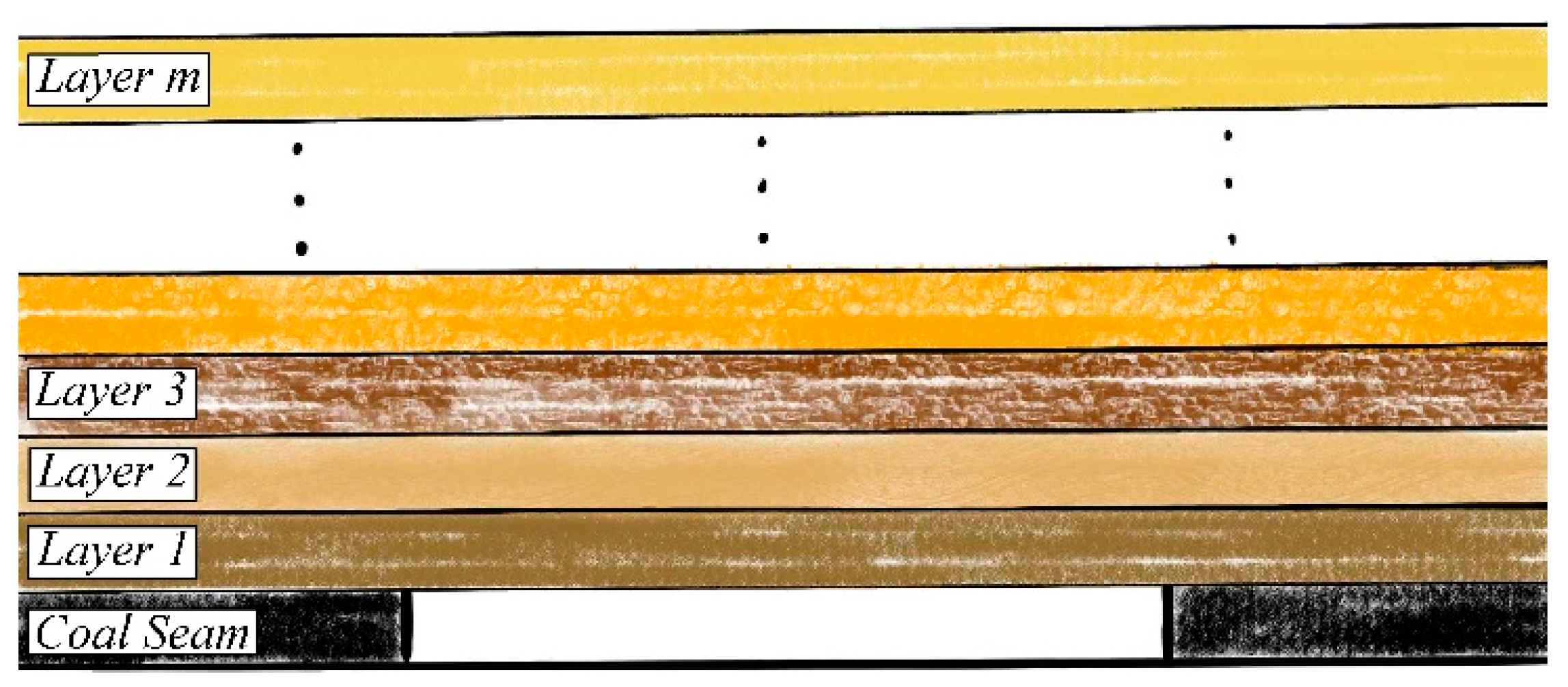
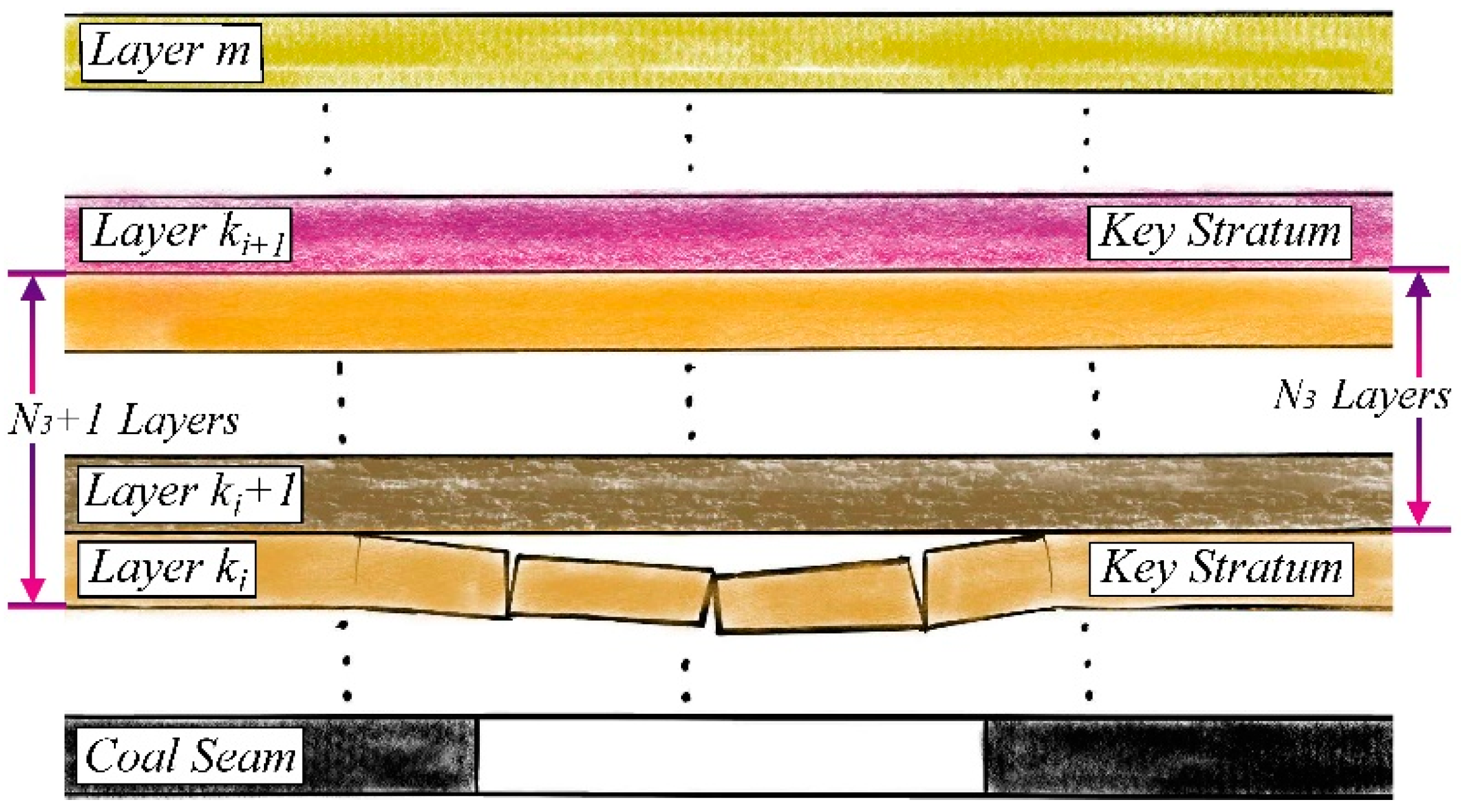


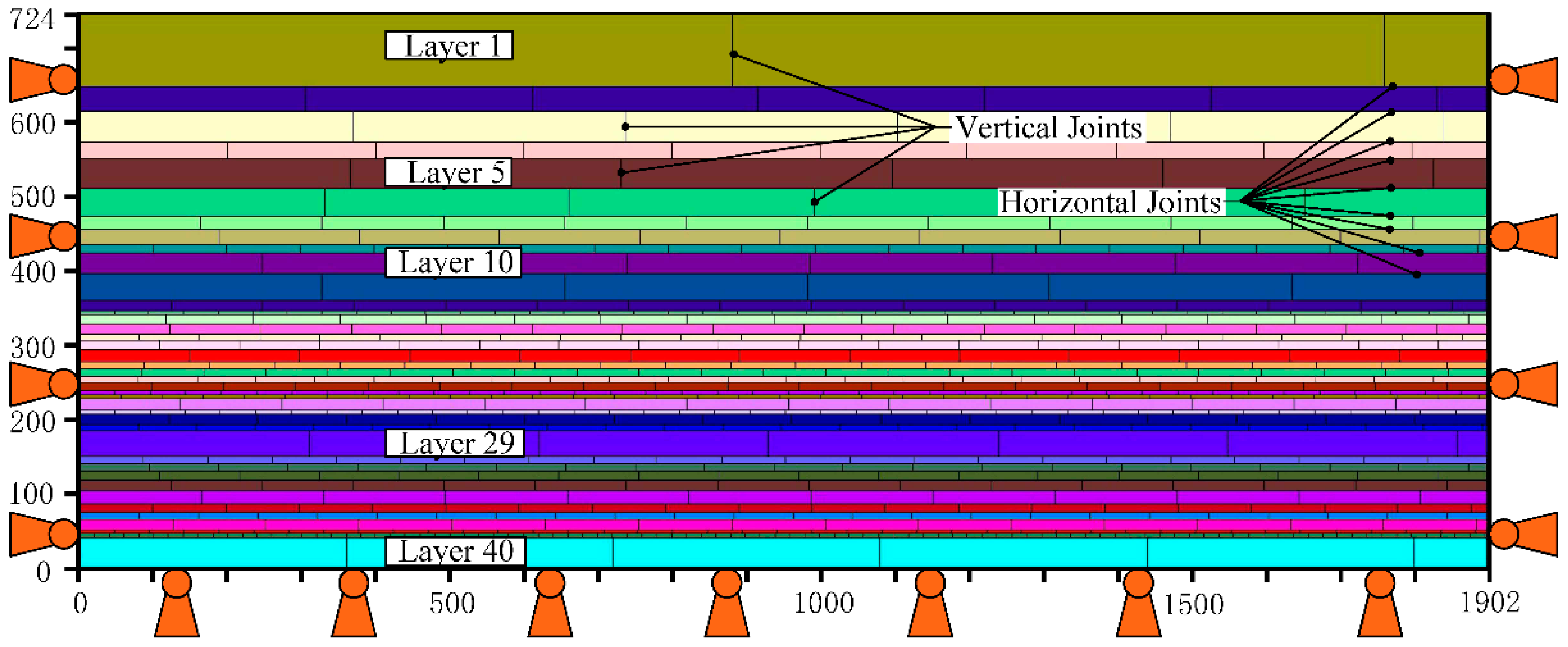
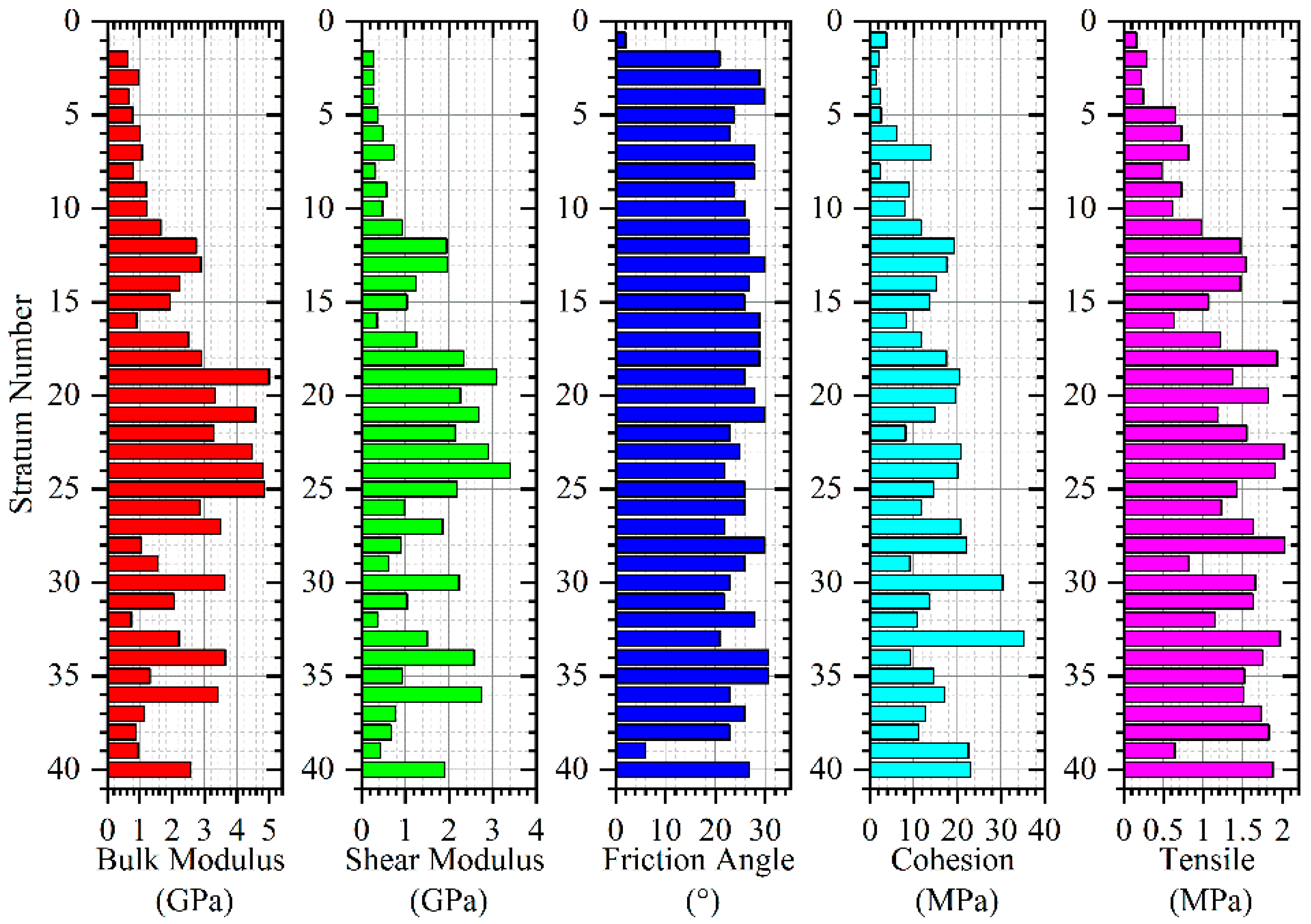

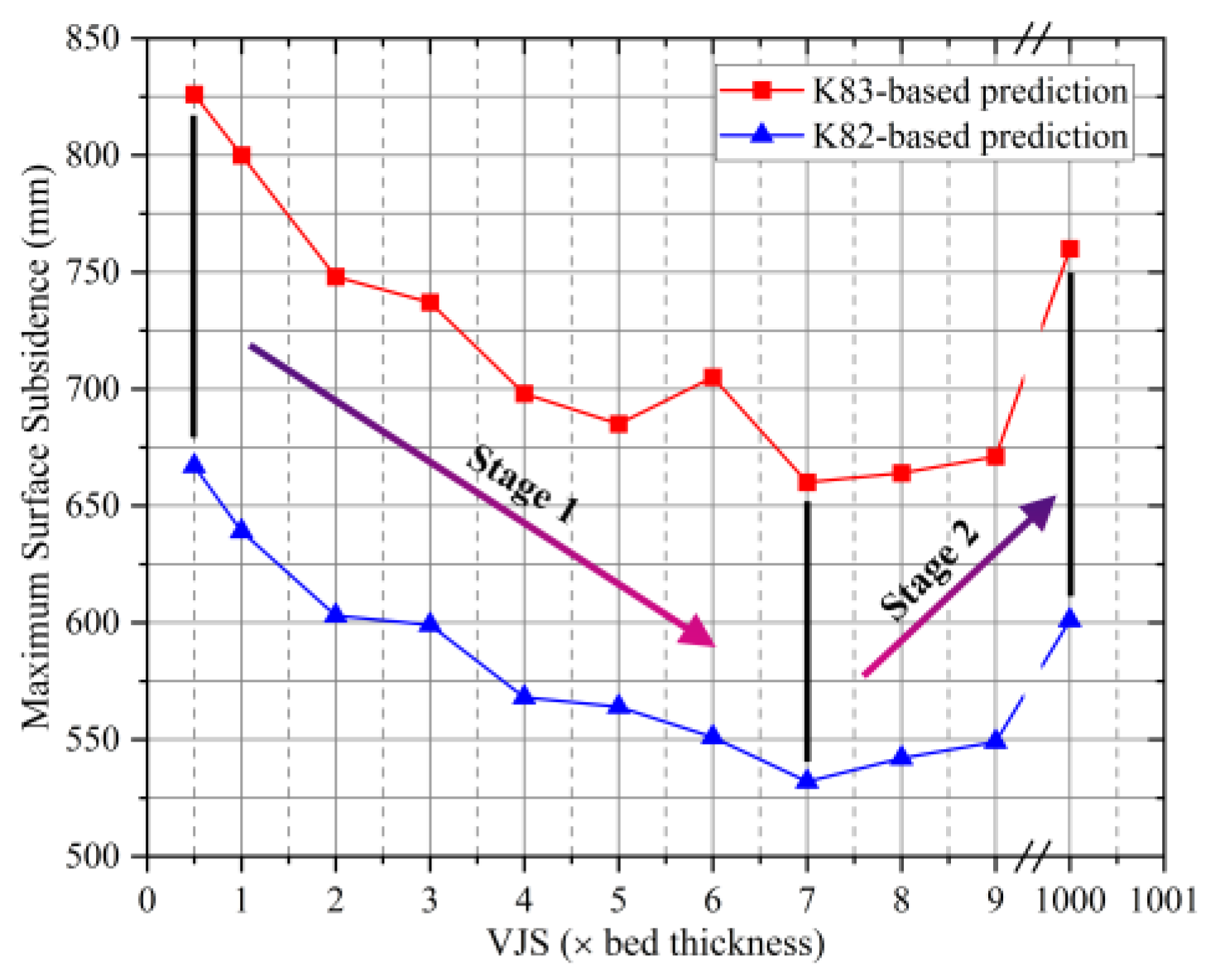




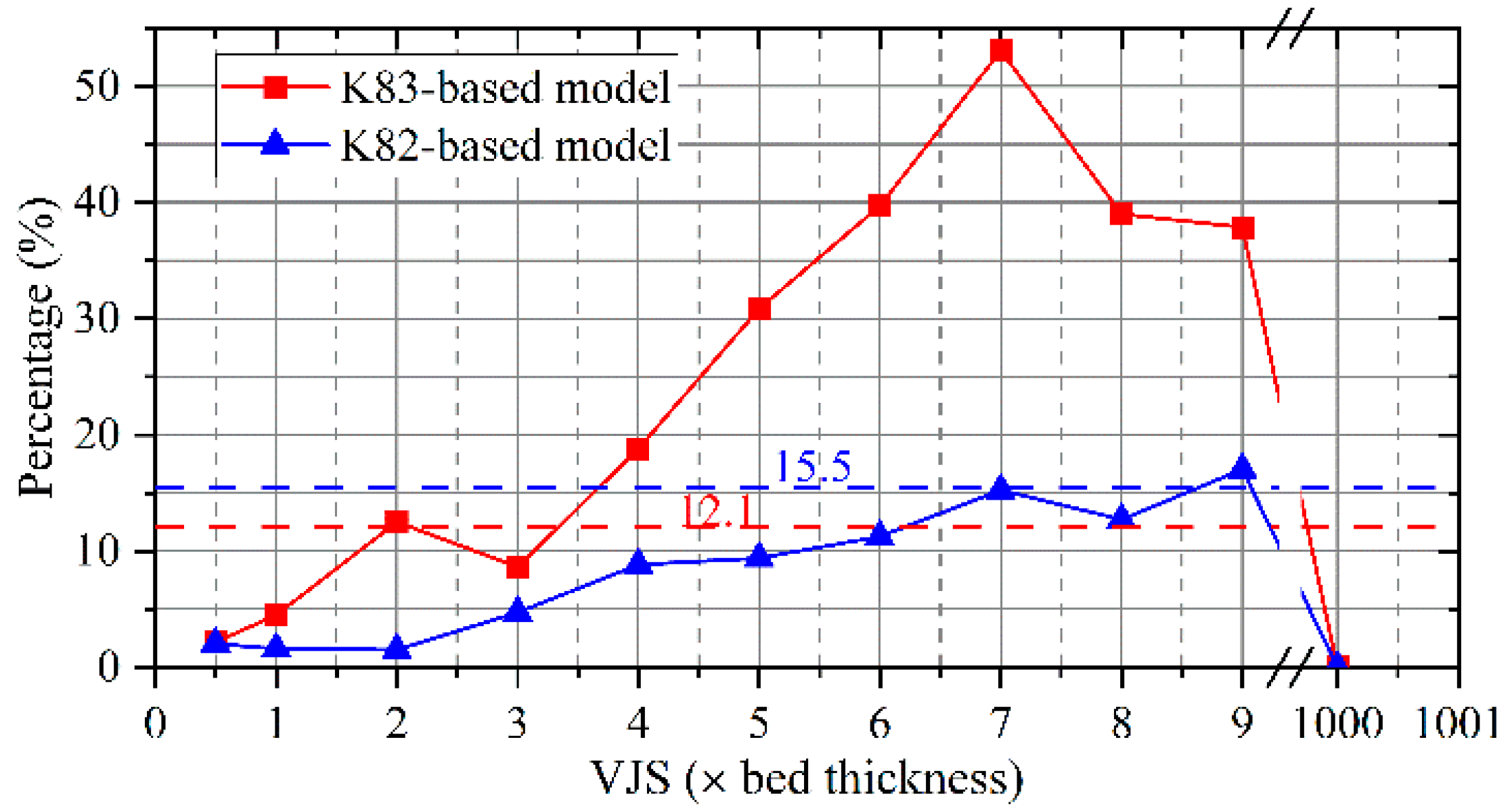
| No. | Lithology | Thickness (m) | No. | Lithology | Thickness (m) | No. | Lithology | Thickness (m) |
|---|---|---|---|---|---|---|---|---|
| 1 | Quaternary | 97.9 | 15 | Mudstone | 34.4 | 29 | Sandy Mudstone | 34.4 |
| 2 | Fine Sandstone | 33.9 | 16 | Siltstone | 9.6 | 30 | Siltstone | 9.6 |
| 3 | M-G Sandstone | 40.9 | 17 | Sandy Mudstone | 10.4 | 31 | Fine Sandstone | 10.4 |
| 4 | Fine Sandstone | 22.2 | 18 | Siltstone | 12.0 | 32 | Siltstone | 12.0 |
| 5 | C-G Sandstone | 40.6 | 19 | M-G Sandstone | 13.6 | 33 | Fine Sandstone | 13.6 |
| 6 | M-G Sandstone | 36.7 | 20 | Siltstone | 18.3 | 34 | M-G Sandstone | 18.3 |
| 7 | Fine Sandstone | 18.2 | 21 | Siltstone | 11.0 | 35 | C-G Sandstone | 11.0 |
| 8 | C-G Sandstone | 21.0 | 22 | Sandy Mudstone | 8.9 | 36 | Mudstone | 8.9 |
| 9 | Fine Sandstone | 11.0 | 23 | Fine Sandstone | 13.9 | 37 | Sandy Mudstone | 13.9 |
| 10 | Fine Sandstone | 27.4 | 24 | C-G Sandstone | 5.2 | 38 | Siltstone | 5.2 |
| 11 | M-G Sandstone | 36.4 | 25 | Sandy Mudstone | 6.9 | 39 | Coal | 6.9 |
| 12 | C-G Sandstone | 13.7 | 26 | Sandy Mudstone | 40.0 | 40 | Floor | 40.0 |
| 13 | Mudstone | 5.2 | 27 | Siltstone | 34.4 | |||
| 14 | Sandy Mudstone | 13.0 | 28 | M-G Sandstone | 9.6 |
| No. | Lithology | Thickness (m) | No. | Lithology | Thickness (m) | No. | Lithology | Thickness (m) |
|---|---|---|---|---|---|---|---|---|
| 1 | Quaternary | 95.7 | 13 | Fine Sandstone | 5.2 | 25 | Fine Sandstone | 9.4 |
| 2 | Fine Sandstone | 54.0 | 14 | Sandy Mudstone | 9.6 | 26 | Sandy Mudstone | 36.9 |
| 3 | M-G Sandstone | 17.5 | 15 | Fine Sandstone | 8.2 | 27 | Sandy Mudstone | 23.8 |
| 4 | Fine Sandstone | 40.6 | 16 | Siltstone | 21.1 | 28 | Fine Sandstone | 9.8 |
| 5 | Siltstone | 13.4 | 17 | Sandy Mudstone | 8.7 | 29 | Siltstone | 26.6 |
| 6 | Fine Sandstone | 32.2 | 18 | Fine Sandstone | 10.0 | 30 | Sandy Mudstone | 7.5 |
| 7 | M-G Sandstone | 27.7 | 19 | M-G Sandstone | 5.0 | 31 | M-G Sandstone | 19.4 |
| 8 | Siltstone | 12.4 | 20 | Sandy Mudstone | 12.1 | 32 | Siltstone | 14.9 |
| 9 | Fine Sandstone | 64.3 | 21 | Sandy Mudstone | 7.7 | 33 | Coal | 6.1 |
| 10 | M-G Sandstone | 20.1 | 22 | Sandy Mudstone | 11.5 | 34 | Floor | 44.1 |
| 11 | Fine Sandstone | 42.0 | 23 | M-G Sandstone | 9.9 | |||
| 12 | Sandy Mudstone | 8.8 | 24 | Sandy Mudstone | 10.1 |
Publisher’s Note: MDPI stays neutral with regard to jurisdictional claims in published maps and institutional affiliations. |
© 2021 by the authors. Licensee MDPI, Basel, Switzerland. This article is an open access article distributed under the terms and conditions of the Creative Commons Attribution (CC BY) license (https://creativecommons.org/licenses/by/4.0/).
Share and Cite
Gong, Y.; Guo, G.; Zhang, G.; Guo, K.; Du, Q.; Wang, L. A Vertical Joint Spacing Calculation Method for UDEC Modeling of Large-Scale Strata and Its Influence on Mining-Induced Surface Subsidence. Sustainability 2021, 13, 13313. https://doi.org/10.3390/su132313313
Gong Y, Guo G, Zhang G, Guo K, Du Q, Wang L. A Vertical Joint Spacing Calculation Method for UDEC Modeling of Large-Scale Strata and Its Influence on Mining-Induced Surface Subsidence. Sustainability. 2021; 13(23):13313. https://doi.org/10.3390/su132313313
Chicago/Turabian StyleGong, Yaqiang, Guangli Guo, Guojian Zhang, Kaikai Guo, Qiu Du, and Liping Wang. 2021. "A Vertical Joint Spacing Calculation Method for UDEC Modeling of Large-Scale Strata and Its Influence on Mining-Induced Surface Subsidence" Sustainability 13, no. 23: 13313. https://doi.org/10.3390/su132313313






